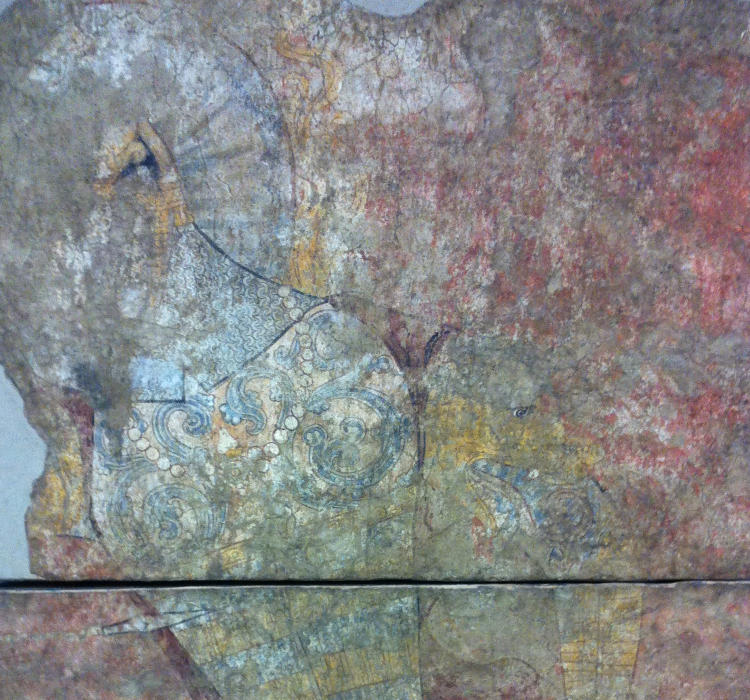
Try Amazon Audible Premium Plus and Get Up to Two Free Audiobooks
An Armoured Warrior, Sector VI, room 55, Sogdian Piandjikent

A larger detail of this Armoured Warrior, Sector VI, room 55, Sogdian Piandjikent.


Mural from Sogdian Penjikent.
Source: Eran ud Turan
Fig. 55. Penjikent. Warrior.
Drawing of the painting on the northern wall of room 55 of sector VI.
1 - general view; 2, 3 - detail drawings.
The armour made of plates in Penjikent is depicted on the western wall of room 13 of sector VI, on the northern wall of room 55 of sector VI (Fig. 55), on the southern wall of room 1 of object VI. A rider, painted on a shield from Mount Mug, is wearing plate armour. The painting from Varakhsha also contains figures of warriors in plate armour (Fig. 56).
...
3. Rows of small rectangular plates with two semicircular protrusions on one side of the plates alternate with rows of plates with a figured contour, which, perhaps, conveys not the edge of the plate, but two pairs of holes characteristic of lamellar armour, through which the laces passed. Waist to hem - 14 rows of plates. 7 rows of plates are visible on the chest, and then the mantle begins. The warrior depicted on the mural on the northern wall of room 55 of sector VI is wearing such armour (Fig. 55, 1). The rest of the armour design is the same as the previous ones.
Source: V. I. Raspopova, Metal products of early medieval Sogd, 1980.
Referenced as Fig. 52: King Fighting. Room 55/VI in pp.102-105, Legends Tales & Fables In The Art Of Sogdiana by Boris Marshak, 1995.
The characters in Rooms 42 and 55 are an elderly king with a beard, a halo and tongues of flame over his shoulder, and a female warrior. In this cycle the supernatural charisma of the king is stressed more than elsewhere in the Penjikent murals (Fig. 52). The narrative probably began near the doorway on the western wall of Room 42. Then it continued along the western wall of the neighbouring Room 55 and along its northern, eastern and southern walls. The story was taken up again on the northern wall of Room 42 and then along its eastern and southern walls. A well-preserved fragment was discovered on the northern wall of Room 55 (Fig. 52). It represents a battle: the king in his lamellar armour is stabbing his enemy with his sword. An arrow head (or the point of a spear) is directed at the king’s breast. This scene is certainly not the first episode of the narrative. In the following episode another warrior in full lamellar armour is killed with an arrow (or a spear) (Fig. 53). In the third episode, a female warrior appears, sword in hand, but wearing rich garments (Fig. 54). The most probable interpretation is that she intends to support the partly defeated army of the king. Then, by the time we reach Room 55, she is shown in her full armour (Fig. 55). She is fencing with a man in chain mail. On the same wall there are figures of a slain warrior falling and two kneeling figures in full armour, one of which is female. They are smaller than the figures of the fighters. However, it may be the same female warrior depicted in both scenes. She and another hero could be shown, kneeling before a king or their commander-in-chief.
There are a number of warlike women in the Shah-nameh and in the epics of the Central Asian Turkic peoples. A. M. Belenitskii thought that the woman could be Gurd-Afarid, the daughter of the ruler of the fortress Safid-Diz. In the Shah-nameh, she fights unsuccessfully with Suhrab the son of Rustam, after the defeat of a young warrior from her father’s garrison. It is hard to explain why her father could be presented as a possessor of the royal farn: but in the mural only he, and not the heroine, has a halo and tongues of flame over his shoulders. Moreover, the father of Gurd-Afarid does not fight. More probably, the story from the Shah-nameh is only typologically similar to the subject of the murals in Rooms 42 and 55.
In this house, including the ‘Rustam Room’ and these two additional rooms, we find illustrations to a whole library of the secular books so poorly represented among Sogdian and other Middle Iranian literary texts which have come down us.
Referenced as figure 440 in The military technology of classical Islam by D Nicolle
440. Fresco from Piandjikent Room VI/55, 7th-8th centuries AD, Transoxanian, Hermitage, Leningrad (Aka S, Yaku).